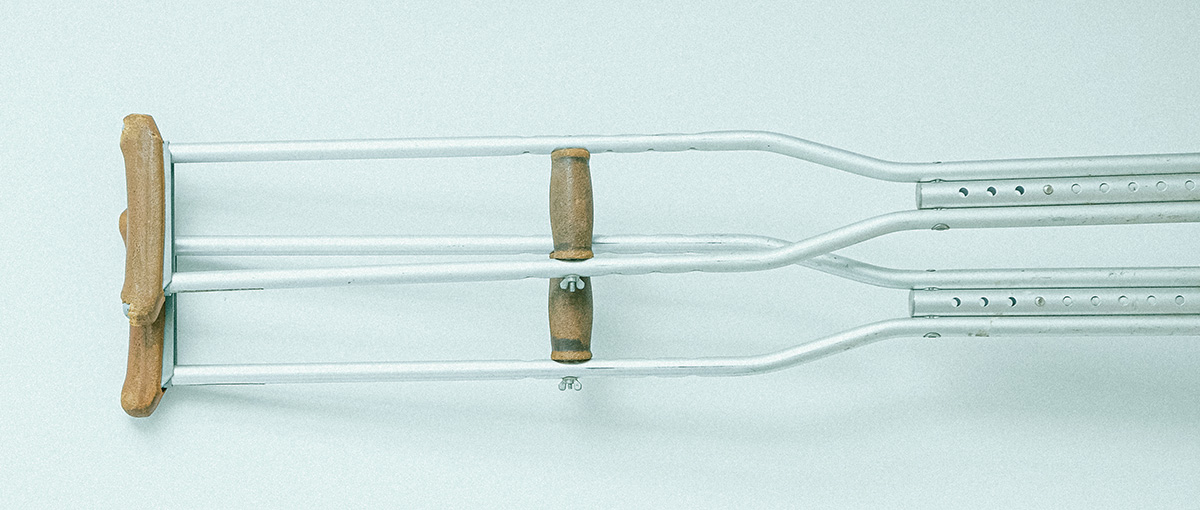Non-weight bearing
Andrew “Fred” Robinson, Consultant Foot and Ankle Surgeon
Moira Burgham, Nursing Sister
You may have been told you that you will be non-weight bearing on your operated leg after your surgery. This means you will have to hop on your good leg, with your operated leg not touching the floor. The time you will be non-weight bearing varies, but is usually for 2 weeks. This will affect many daily activities and can be very tiring, so it is a good idea to plan ahead as you will need some support at home.
Walking aids
A physiotherapist will assess your mobility after your surgery, and will teach you to use an appropriate walking aid. This will probably be crutches or in some cases a walking frame. A frame provides more support for patients with poor balance, or weak arms, but for most people crutches suffice. The hospital does not loan equipment, and you will be charged for crutches or a frame. Frames can be hired from the Red Cross. If you have borrowed equipment please bring it to the hospital with you. The physiotherapist can then check that it is safe and the correct height.
Wheelchairs
Some patients find it useful to hire a wheelchair to allow them to get out and about. It is advisable to have an adjustable footrest that will keep the operated leg elevated.
A few patients, who already have existing mobility problems or weakness in their unaffected leg or arms, may not manage to hop with a frame. They will have to transfer from chair to bed or toilet, and use a wheelchair for getting around. In this case it is necessary to check the width of doorways and if there is adequate space in the toilet. It may be necessary to hire a commode temporarily.
Sitting to standing
It can be quite difficult to get from sitting to standing from a low chair, especially if your unaffected leg is weak, so it may be advisable to sit in an upright chair with arms.
It may also be helpful to hire a toilet frame and raised toilet seat as toilets seats are usually low.
Stairs
The physiotherapist will show you how to manage stairs with crutches. If you have weak arms, or are using a frame, you will have to do the stairs on your bottom. The main difficulty is standing back up when you get to the top of the stairs. You can use a low stool to lift you up in stages. Alternatively you can try getting on your hands and knees and pulling yourself up on a chair. It is useful to try this at home before your surgery; it can be harder than you think. Alternatively, you can bring a bed downstairs temporarily.
Washing
It is important to keep the cast and dressing dry. The nurse or physiotherapist can give you information about a product that will keep your leg dry while you shower. It is possible to shower in a walk in shower by sitting on a plastic stool or chair. Alternatively you can bathe/shower by sitting on a bath board. Wet wipes are useful for cleaning between your toes.
Swelling
For the first 2 weeks it is advisable to keep swelling to a minimum by keeping your leg elevated to the same height as your bottom on a pouffe or a stool, for at least 45 minutes each hour. Alternatively you can sit on a sofa, with your legs across it.
Safety
It is essential to take extra care when using crutches or a frame. Beware of hazards such as pets, slippery floors and loose rugs.
If you live alone
It is advisable to stay with someone, or arrange for someone to come in and help you with household tasks, shopping and pets. A small rucksack is useful for carrying things around the house, but you will not be able to carry drinks and plates of food while you are non-weight bearing.
Equipment
It is possible to borrow most of the equipment mentioned above, from your local Red Cross on a short-term loan, for a small fee or donation.
Contact details for the Red Cross
Cambridge 01223 868696
Unit C, 511 Coldhams Lane, Cambridge, CB13JS
Ely 01353 664147
19 West Fen Road, Ely, Cambridgeshire, CB6 1AN
St Neots 01480 213376
Cemetery Road, St Neots, PE19 2BX

